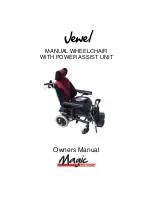
51
50
6.2.3
Punctures
If pneumatic tyres are punctured by
sharp objects such as nails, screws, glass
slivers etc., the puncture should be re-
paired (by mending the inner tube) or
the tube replaced.
!
Attention:
Before repairing a tyre, the air valve
must be opened in order to let out
the air remaining in the tube.
6.2.3.1 Tyre change on the drive
wheels
!
Attention:
The outer part of the tyre must be
removed and replaced using appro-
priate tyre levers (bicycle accessories).
Do not use a screwdriver or other
pointed or sharp-sided object as a
lever!
74
75
1
6.2.3.2 Tyre change on the swivel
wheels
Before replacement or repair, the swivel
wheel axle must be removed (fig. 74).
☞
Note:
Observe the position of any sleeves
or washers for reassembly.
To change the wheel, first screw out the
screws on the outer edge of the rim (fig.
75/
➀
). Now separate the rim halves.
6.2.2
Maintenance instructions
Before setting out:
▲
Check brake unit for correct function.
Operate brake lever until it reaches
its limit. The locked wheels should not
be able to turn under operating con-
ditions. If they can still turn, the
brakes must be repaired by an au-
thorized specialist workshop.
▲
Check toggle joint brake for wear.
Move brake lever sideways. There
should not be excessive play.
▲
Check tyre pressure.
Standard values
Standard tyre: 2.5 bar
Smooth running tyres: 7,5 bar
☞
Note:
Always observe the pressure stated
on the tyre.
▲
Check tyre profile.
If the tyre profile is worn down or if
the tyre is damaged, consult an au-
thorized specialist workshop for re-
pairs.
▲
Check rear tubes for stability.
In the event of deformation or crack-
ing around the soldered seams, con-
tact an authorised repair centre im-
mediately for repair. – Danger of ac-
cidents!
Every 8 weeks
(depending on frequency of use)
▲
Lubricate the following components
with a few drops of oil:
– Cross brace bearings.
– Moving parts of the locking
mechanism.
– Brake lever bearings.
Components must be free from used
oil residues before lubrication.
Please ensure that excess oil does not
contaminate the environment (e.g.
your clothing)
▲
Check that all screwed connections
are tight.
▲
Check that the sliding handles are
tight by forceful twisting.
Every 6 months
(depending on frequency of use)
▲
Check:
– Cleanliness, see Care section.
– General condition, see Care and
maintenance section.



































